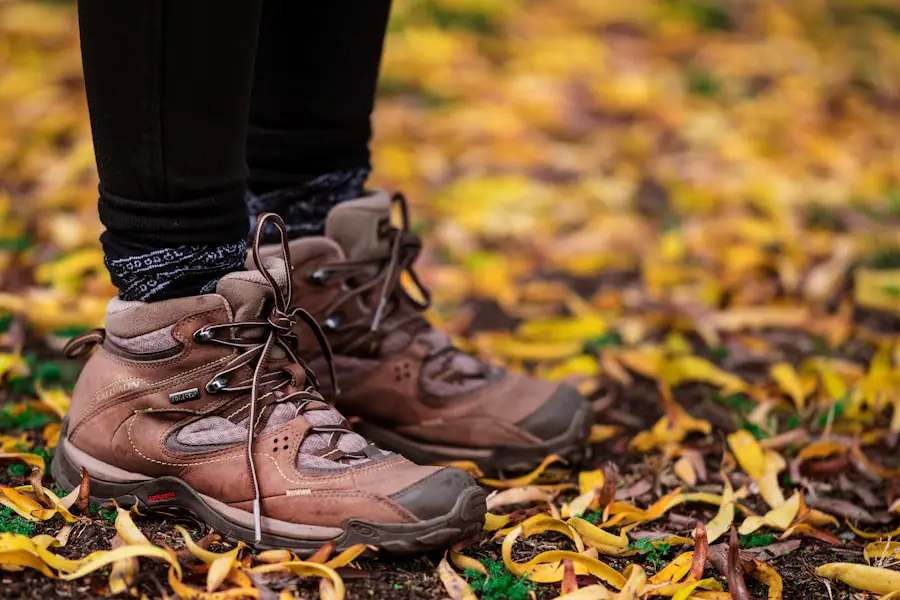Layering is a fundamental principle in outdoor clothing that allows hikers to adapt to changing weather conditions and varying levels of physical exertion. The concept revolves around three primary layers: the base layer, the insulating layer, and the outer layer. Each layer serves a distinct purpose, contributing to overall comfort and protection during hikes.
The base layer, typically made from moisture-wicking materials such as merino wool or synthetic fabrics, is designed to draw sweat away from the skin. This is crucial because staying dry is essential for maintaining body temperature and preventing chills, especially in cooler weather. The insulating layer, which can be a fleece jacket or a down vest, traps heat generated by the body while still allowing moisture to escape.
This layer is particularly important during colder months when temperatures can drop significantly.
The outer layer, often referred to as the shell, provides protection against wind, rain, and snow. Materials like Gore-Tex or other waterproof fabrics are commonly used for this purpose.By combining these three layers effectively, hikers can create a versatile system that can be adjusted according to the conditions they encounter on the trail. For instance, if the sun comes out and temperatures rise, hikers can easily remove the insulating layer without compromising their overall comfort.
Key Takeaways
- Layering is essential for fall hiking to regulate body temperature and stay comfortable.
- Choose footwear with good traction and ankle support for stability on uneven terrain.
- Invest in weatherproof outerwear to stay dry and protected from the elements.
- Opt for comfortable bottoms that allow for freedom of movement and protection from brush and debris.
- Protect your head and hands with a hat, gloves, and sunglasses to shield from sun and wind.
Footwear Selection:
Terrain and Ankle Support
If you are planning to tackle rocky trails or uneven surfaces, a sturdy pair of hiking boots with good ankle support is essential. These boots often feature rugged outsoles designed for traction, which can help prevent slips and falls on challenging terrain. Brands like Merrell and Salomon offer a variety of options that cater to different hiking needs, ensuring that hikers can find a suitable fit for their adventures.
Trail Running Shoes
On the other hand, if your hike involves well-maintained paths or shorter distances, trail running shoes may be a more appropriate choice. These shoes are typically lighter and more breathable than traditional hiking boots, allowing for greater agility and speed on the trail. However, it’s important to ensure that they still provide adequate support and grip.
Weather Conditions and Quality Footwear
Additionally, consider the weather conditions when selecting footwear; waterproof options are advisable for wet or muddy trails, while breathable materials are preferable in warmer climates. Ultimately, investing in high-quality footwear tailored to your specific hiking conditions can significantly enhance your comfort and performance on the trail.
Weatherproof Outerwear:

When venturing into the great outdoors, having reliable weatherproof outerwear is non-negotiable. The unpredictability of nature means that rain showers or sudden drops in temperature can occur without warning. A high-quality waterproof jacket is an essential piece of gear for any hiker.
Look for jackets that feature sealed seams and breathable fabrics to ensure that you stay dry while also allowing moisture from sweat to escape. Brands like Patagonia and The North Face offer jackets that combine durability with lightweight designs, making them ideal for long hikes where every ounce counts. In addition to jackets, consider investing in weatherproof pants as well.
Many outdoor brands now offer lightweight, breathable pants that are both water-resistant and quick-drying. These pants can provide an extra layer of protection against rain and wind while also being comfortable enough for extended wear. Furthermore, features such as zippered pockets and adjustable cuffs can enhance functionality, allowing hikers to store essentials securely and adjust their fit as needed.
By equipping yourself with quality weatherproof outerwear, you can confidently face whatever elements nature throws your way.
Comfortable Bottoms:
| Product | Material | Price | Customer Rating |
|---|---|---|---|
| Leggings | Cotton-Spandex Blend | 25.99 | 4.5/5 |
| Sweatpants | Fleece | 35.00 | 4.2/5 |
| Yoga Pants | Nylon-Spandex Blend | 29.99 | 4.7/5 |
The choice of bottoms for hiking is just as important as selecting the right footwear. Comfort is paramount when spending hours on the trail, and the right pair of pants or shorts can make all the difference in your experience. For cooler weather hikes, consider wearing moisture-wicking long pants made from synthetic materials or merino wool blends.
These fabrics not only keep you warm but also help regulate body temperature by wicking away sweat. Look for pants with features like articulated knees and stretch fabric to allow for greater mobility while navigating uneven terrain. In warmer conditions, lightweight shorts or convertible pants that can be zipped off into shorts are excellent options.
These versatile garments provide breathability while still offering protection from sun exposure and potential scrapes from brush or rocks. Additionally, many hiking shorts come equipped with pockets designed for easy access to small items like snacks or maps. When selecting bottoms, pay attention to fit; a snug but comfortable fit will prevent chafing and allow for freedom of movement during your hike.
Head and Hand Protection:
Protecting your head and hands during a hike is crucial for comfort and safety. A good hat serves multiple purposes: it shields your face from harmful UV rays, keeps you cool in hot weather, and provides warmth in colder conditions. Wide-brimmed hats are particularly effective at blocking sunlight, while beanies or fleece-lined caps are ideal for chilly hikes.
Look for hats made from moisture-wicking materials that can help keep sweat at bay during strenuous activities. Hand protection is equally important, especially in colder climates where frostbite can be a concern. Insulated gloves or mittens made from waterproof materials will keep your hands warm and dry while allowing for dexterity when handling gear or navigating trails.
For milder conditions, lightweight gloves made from breathable fabrics can provide just enough warmth without overheating. Additionally, consider using glove liners that can be worn underneath heavier gloves for added insulation on particularly cold days. By prioritizing head and hand protection, you can ensure that you remain comfortable and focused on your hike.
Hydration and Snack Accessories:

Staying hydrated is vital during any outdoor activity, particularly hiking where physical exertion can lead to rapid fluid loss. A reliable hydration system is essential; many hikers opt for hydration packs or water bottles that are easy to carry and access while on the move. Hydration packs come equipped with a reservoir and a tube for sipping water without needing to stop frequently, making them an excellent choice for longer hikes where convenience is key.
In addition to hydration, having snacks readily available can help maintain energy levels throughout your hike. Lightweight snack containers or pouches designed specifically for outdoor use can keep trail mix, energy bars, or fruit secure and easily accessible. Look for containers that are durable and waterproof to protect your food from moisture or accidental spills.
Planning your snacks ahead of time ensures you have a balanced mix of carbohydrates, proteins, and fats to sustain you on the trail.
Navigation and Safety Gear:
Navigating unfamiliar trails requires proper gear to ensure safety and directionality throughout your hike. A reliable map of the area is essential; even in this digital age where GPS devices are prevalent, having a physical map as a backup is wise in case of technology failure or loss of signal in remote areas. Familiarizing yourself with topographic maps can provide valuable insights into elevation changes and potential hazards along your route.
In addition to maps, consider carrying a compass or a GPS device for precise navigation. Many modern GPS devices come equipped with features such as waypoint marking and route tracking, which can enhance your hiking experience by allowing you to explore new trails confidently. Safety gear should also include a first aid kit tailored to your needs; this kit should contain essentials such as band-aids, antiseptic wipes, pain relievers, and any personal medications you may require during your hike.
By equipping yourself with navigation tools and safety gear, you can hike with confidence knowing you’re prepared for any situation.
Optional Accessories for Fall Hiking:
As fall approaches, the changing landscape brings unique challenges and opportunities for hikers. While many of the essentials remain constant throughout the year, certain accessories become particularly beneficial during this season. One such accessory is trekking poles; these provide stability on uneven terrain while also reducing strain on joints during descents.
Adjustable poles allow hikers to customize their height based on their comfort level and terrain type. Another optional accessory worth considering is a lightweight backpacking chair or sitting pad. As temperatures cool down, taking breaks becomes more enjoyable when you have a comfortable place to sit and rest your legs.
These items are typically compact and easy to carry, making them an excellent addition to your gear list without adding significant weight. Additionally, consider packing an extra layer such as a lightweight poncho or emergency blanket; these items can provide warmth or protection from unexpected weather changes during fall hikes when conditions can shift rapidly. By carefully selecting your gear based on these categories—layering basics, footwear selection, weatherproof outerwear, comfortable bottoms, head and hand protection, hydration accessories, navigation tools, and optional fall accessories—you can enhance your hiking experience significantly.
Each element plays a crucial role in ensuring comfort, safety, and enjoyment on the trail as you explore the beauty of nature throughout the seasons.
If you’re planning a fall hiking trip, it’s important to dress appropriately for the changing weather. One essential item to consider is a reliable hiking backpack for multi-day treks. Check out this article on the best hiking backpack for multi-day trek to ensure you have the right gear for your adventure.
FAQs
What should I wear for fall hiking?
In fall, it’s important to wear layers to stay warm and dry. Start with a moisture-wicking base layer, add a insulating layer, and finish with a waterproof and windproof outer layer.
What type of pants are best for fall hiking?
For fall hiking, it’s best to wear quick-drying and moisture-wicking pants. Consider wearing convertible pants that can be zipped off into shorts if the weather warms up.
What kind of footwear is suitable for fall hiking?
Choose sturdy and waterproof hiking boots with good ankle support for fall hiking. Make sure they have a good grip for slippery and muddy trails.
What accessories should I bring for fall hiking?
Bring a warm hat, gloves, and a scarf to protect yourself from the cold. Don’t forget to bring a backpack with essentials like water, snacks, a map, and a first aid kit.
What should I consider when choosing a jacket for fall hiking?
Look for a jacket that is waterproof, windproof, and breathable. Consider a jacket with adjustable cuffs and a hood for added protection from the elements.
What type of socks are best for fall hiking?
Choose moisture-wicking and breathable socks to keep your feet dry and comfortable. Consider wearing wool socks for added warmth.
What colors are best for fall hiking clothing?
Neutral and earthy tones like brown, green, and gray are best for fall hiking clothing as they blend in with the natural surroundings and don’t attract insects.
